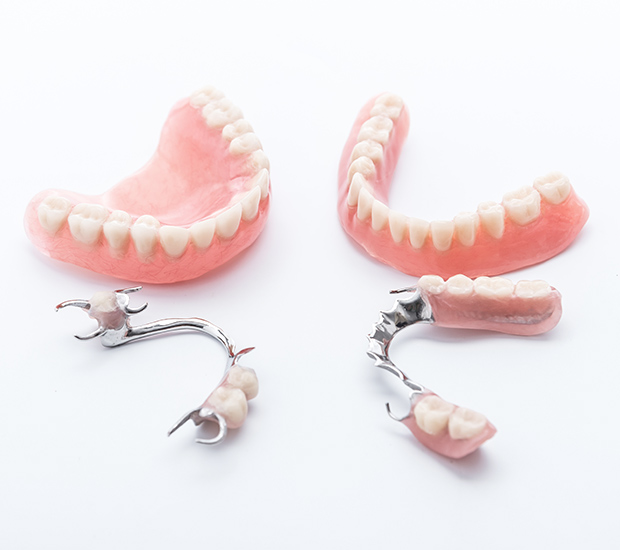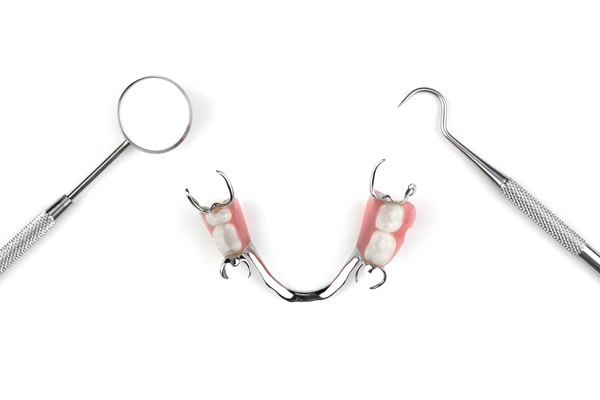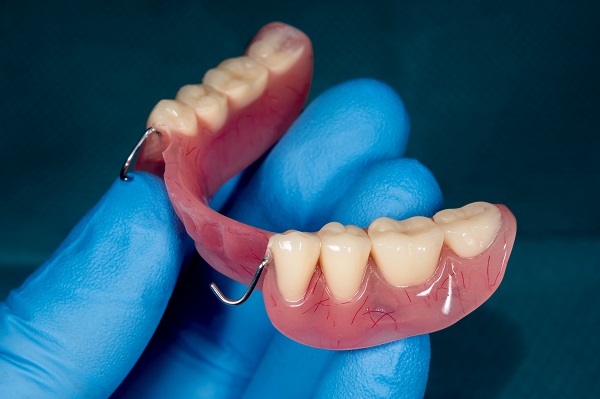Partial Dentures Baton Rouge, LA
While partial dentures are most commonly associated with seniors, many young people wear them too. According to the CDC, adult tooth loss has been on the decline for roughly 70 years. Even so, many Americans rely on dentures to improve not just their smiles but also their speech and ability to chew food comfortably. Partial dentures fill any tooth loss gaps with false teeth.
Partial dentures are available at Elizabeth H Guerrero DDS in Baton Rouge and the surrounding area. We offer a range of tooth replacement options.
If you are ready to learn more about the available options, reach out to us by phone at (225) 360-3914.
Reasons to Consider Getting Partial Dentures
The need for tooth replacement can arise for a variety of reasons. Some people lose teeth due to a traumatic injury or an illness such as diabetes. Others develop problems with their teeth to the point where a dentist may recommend extraction. Whatever the cause, partial dentures offer several benefits as a tooth replacement option:
- Ability to continue eating a regular diet
- Confidence in your appearance
- Clear speech
- Oral health
Partial dentures can provide an effective solution for many problems missing teeth can cause. Leaving gaps can promote bacterial growth, which can lead to cavities in the remaining teeth, gum disease, and infections. Neighboring teeth can also become weaker from the lack of structural support on the side of the gap.
Many people also have concerns about their appearance. Even when the missing teeth are closer to the back and not immediately visible when a person smiles, they can affect facial muscle tone over time. According to an article on dental health and headaches by the American Academy of Craniofacial Pain, the muscle strain from a missing tooth can cause ongoing headaches.
Check out what others are saying about our partial denture services on Yelp: Partial Dentures Baton Rouge
Choosing Partial Dentures for Tooth Replacement
Partial dentures only represent one of the many options patients can choose from.
When to Get Partial Dentures
Partial dentures become a viable option almost every time someone loses their teeth. Even the loss of one tooth can result in the use of partial dentures to rectify the problem. If a person decides to get implants or bridges, they may still wear dentures temporarily until this work is completed.
Note that young people lose their teeth too. One of the most common reasons for this is facial trauma, such as a sporting injury, motor vehicle accident, or a bad fall. These instances can lead to not just missing teeth, but also cracking and breaking.
In addition to this, young people may struggle with cavities. In fact, tooth decay affects people of all ages, especially those who love sugary foods and fizzy drinks. People with poor dental hygiene may also suffer more from caries than others.
Another effect of poor dental hygiene is gum disease, which is sometimes known as periodontal disease. This infection of the gums and the material surrounding the teeth may lead to complete tooth loss over time. People who smoke are more likely to suffer from gum disease than others.
Finally, there are several other health conditions and medications that may result in tooth loss. Diabetes, ectodermal dysplasia, rheumatoid arthritis, and gastrointestinal reflux may all increase the likelihood of tooth loss over time.
How Partial Dentures Are Made
Some processes may differ depending on the materials used in making partial dentures, but it typically advances in the following sequence.
The process starts with taking an impression of the mouth. The dentist then creates a model using dental stone as a cast. The doctor may then ask the patient to try several different sets of sterilized partial dentures to determine the ideal fit as well as the preferred color and size of the teeth. After these selections, the dentist may then make some adjustments to the cast. Thereafter, it is sent to a dental laboratory for completion.
At the dental lab, technicians may then create a wax version of the gum line. These technicians make the replacement teeth from a material that closely resembles real teeth known as resin. Virtually all labs then seek approval from the patient and dentist before proceeding with the finishing touches.
Following approval, the technician removes the wax and replaces it with acrylic, which looks far more realistic. This process entails boiling to get rid of the wax, drilling holes in the teeth, and then injecting the acrylic. Finally, technicians clean up the teeth and polish the appliance. The entire process may require the patient to visit the dentist’s office four to five times.
Types of Dentures
When patient’s lookup types of dentures, they mostly come across full dentures and partial dentures. However, these are just the tip of the iceberg. Over the past few years, dentists created hybrids with other dental treatments to provide patients with even more options. You may contact one of our Elizabeth H Guerrero DDS team members to find out which denture is right for you. Our practice offers partial dentures for patients who need to replace a few missing teeth to restore their smile.
When a patient still has teeth to blend in and anchor with the newly created teeth, the dentist may recommend partial dentures. This may require the use of a metal piece to which a pink-colored base is attached. The metal helps to anchor the false teeth to the natural teeth to prevent movement.
Other Tooth Replacement Options
In addition to partial dentures, patients may want to consider other ways to replace missing teeth. When deciding which option to choose, there are a few factors to consider, such as cost, general dental health, and your lifestyle.
While implants are most likely to create the feeling of having a natural set of teeth, they are not always a feasible option. Cost is a top concern, especially when many or all teeth need replacement. According to WebMD, gum and bone health is important for successful implants.
Another option is an implant- or tooth-supported fixed bridge. This works similarly to the implant-supported denture but is not removable. Instead of clipping on to the teeth or implants, however, the bridge is affixed with cement or a screw. In addition to costing more than dentures, this option does not work with all configurations of missing teeth.
In the case of missing front teeth, dentists sometimes recommend a resin-bonded bridge. It is not very durable, which is why it is not used to replace other types of teeth that typically take more strain when chewing. It consists of a tooth replacement held on two wings that attach to the insides of the natural teeth on either side.
Care and Maintenance of the Dentures
Though partial dentures are durable and help the patient once again bite into food, these appliances can break. Partial dentures can also warp or get dirty, so it is vital that people follow proper maintenance guidelines, as described in this article on the American Dental Association website. Our team at Elizabeth H Guerrero DDS will counsel each patient on proper care to extend the life of their partial dentures. Though, ultimately, it is up to the patient to be diligent in routine care and contacting the dentist when problems arise.
After eating a meal, a patient should remove their partial dentures and rinse the appliance thoroughly with water, removing excess food. Also, patients should brush the partial dentures with a soft toothbrush and non-abrasive toothpaste. When it is time to retire for the night, the person should remove the partial dentures. Some people soak their dentures in a solution. You may contact our team to see if a denture solution is recommended for your care routine.
What to Do in Case of Breakage
There are plenty of ways to repair your partial dentures in the event of an accident. It is almost inevitable that patients will find a crack or break in the appliance at some point. The base could crack, or a tooth could break loose. For a quick fix, there are products available online and at most local grocery stores and pharmacies, such as D.O.C.® Repair-It®, Cushion Grip®, and Perk ®'s Denture Repair Kit. If you are considering using a product for a temporary fix, please contact your dental office first. Whenever significant damage occurs, like a large crack across the base, you should seek medical treatment.
In any case of breakage, the denture-wearer should contact our office right away. Our team has the right tools and equipment to fix the partial dentures properly. Patients can feel good that our dental professionals will carefully examine the damage and repair it. If necessary, the dentist may have to replace the partial dentures altogether.
Avoiding Problems
While some situations may be challenging to prevent, patients can minimize repair needs. People with partial dentures should be careful with certain hard foods such as nuts, popcorn kernels, ice, and candy. Some sticky foods may also pull out the dentures. When cleaning the appliance, the individual should place a towel or cloth on the counter or in the sink in case the dentures fall. Denture-wearers who play sports should wear a mouthguard to protect the dentures.
Common Misunderstandings About Partial Dentures
There are many benefits and advantages to getting partial dentures. However, some prospective patients shy away from seeking this treatment because of myths and other false information. Some people do not know enough about dentures and how this treatment can benefit their oral health and the appearance of their face.
People often believe that partial dentures are the last resort when all other options have failed. The fact is that partial dentures are not nearly as invasive as other treatment options. Wearing partial dentures can preserve mouth function as well as any other option.
Another misconception is that it is easy to spot a pair of dentures in a person’s mouth. Partial dentures are natural-looking in the base with artificial teeth. We can help ensure that dentures or partial dentures blend in with the surrounding teeth. Also, while partial dentures can fall out at inopportune times, our dentist can suggest adhesive products to hold the appliance in place.
Questions Answered on This Page
Q. Are there different types of dentures?
Q. Are there dentures to replace a few of my teeth?
Q. What are the benefits of dentures?
People Also Ask
Q. How do I take care of my dentures?
Q. What do I need to know about making adjustments to my dentures?
Definition of Denture Terminology
- Alveolar Bone
- The alveolar bone is the bone surrounding the root of the tooth that keeps the tooth in place.
- Clasp
- A clasp is a device that holds a removable partial denture prosthesis to the teeth.
- Denture Base
- The denture base is the part of the denture that connects the artificial teeth with the soft tissue of the gums.
- Edentulous
- Edentulous is a term that applies to people who do not have any teeth.
- Periodontal Disease
- Periodontal disease is a condition that causes inflammation of the gingival tissues and membrane of the teeth, leading to tooth loss without professional treatment.
- Pontic
- Pontic is another term for an artificial tooth on a fixed partial denture.
- Rebase
- Rebase is the process of refitting denture prosthesis by replacing the base material.
- Reline
- Reline is when a professional resurfaces the surface of the prosthesis with a new base material.
- Resin/Acrylic
- Resin and Acrylic are resinous materials that can be components in a denture base.
- Stomatitis
- Stomatitis is the inflammation of the tissue that is underlying a denture that does not fit properly. It can also result from other oral health factors.
Back to top of Artificial Teeth




